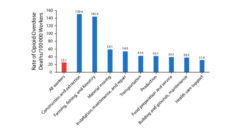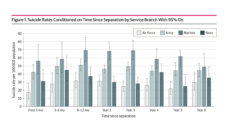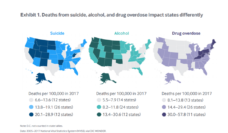Most people will live through at least one traumatic event in their life. Different types of traumas can affect people in various ways, sometimes leading to post-traumatic stress disorder (PTSD). PTSD is a serious and relatively common condition. Approximately 6% of the U.S. population will be diagnosed with PTSD at some point in their lives. Symptoms include intrusive trauma memories, avoidance of trauma reminders, hyperarousal, and nightmares. While not always considered a life-long illness, it can persist into or reoccur in late life.
Given the intensity of these symptoms, many people living with PTSD are prescribed various medications to manage the disorder. Unfortunately, access to these medications may contribute to an increased risk of overdose death and suicide. For example, those with PTSD may be prescribed opioids to help manage pain, but opioids are increasingly associated with overdose deaths and suicide attempts.
Suicide and accidental injuries (which both include overdose) are in the top 10 leading causes of death in the U.S., and are disproportionately high among groups like veterans and middle-aged and older adults. However, few researchers have examined whether late-life suicide risk and unintentional injuries, such as overdose death, are associated with PTSD.
Our research team at the Byers Lab, which has expertise in aging research and psychiatric epidemiology, explored risk of suicide death, suicide attempts, and overdose death among veterans due to their relatively higher rate of PTSD. We looked at mortality data from across the country of veterans aged 50 and older, and compared those with PTSD to those without.
Educating providers, patients, and the public about lethal means safety, including both drugs and firearms, is imperative for saving lives over the long term.
Our analysis found that approximately 50% of veterans with PTSD had increased risk for suicide attempts, and increased risk of death by suicide, whether accidental or by undetermined drug overdose. Noticing the trend with drug overdose, we decided to look at what kinds of drugs may be driving this finding. We found that PTSD increased the risk for overdose death by way of narcotics, anti-epileptic/sedative-hypnotics, and other/unspecified drugs. (This last category was largely defined by multiple [3 or more] drugs contributing to the overdose death.)
We believe our data highlights the importance of extra caution for use of certain classes of prescribed medications and a careful assessment of what other drugs veterans are using. Even though we don’t have data on whether or not the drugs contributing to death were prescribed, or how many of these overdoses were from illicit drugs, this is an important area for future work. From further investigation, we do know that the other/unspecified drug-related causes of death included multiple psychoactive medications with most deaths involving benzodiazepines or opioids (e.g., codeine, morphine, and heroin).
Although our study indicates that the influence of PTSD on risk of suicide death is largely explained by drug overdose risk, we should note that firearms remained the most common means of death by suicide in the older population, at around 0.17% in both groups from our sample. It is also worth noting that although suicide death by firearms overall was the method that occurred most frequently, it occurred similarly (805 of 1213 and 748 of 1139; 66% of both groups) for suicide decedents with or without PTSD. Educating providers, patients, and the public about lethal means safety, including both drugs and firearms, is imperative for saving lives over the long term.
The current study documents the adverse influence and implications of high-risk medications and illicit drugs, and particularly use of multiple drugs, by older adults with PTSD. PTSD may persist into or reoccur in mid- to late-life with considerable increased risk for non-fatal suicide attempts and suicide overdose death. It is vital that providers facilitate drug-monitoring practices (e.g., regularly reassessing dosages of psychoactive medications based on patient’s needs, implementing CDC’s recommendation for state-level prescription drug monitoring programs) in the care of older patients with PTSD. Our sincerest hope for the future is that aging adults receive the care they deserve so we can lessen preventable deaths from unintended overdose and suicide.
Photo via Getty Images















